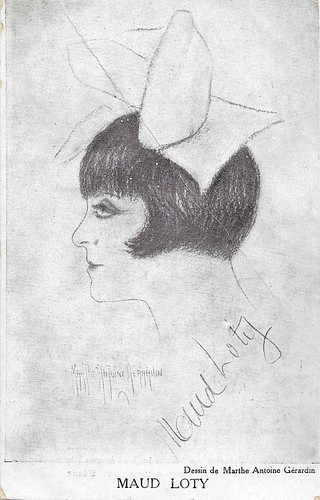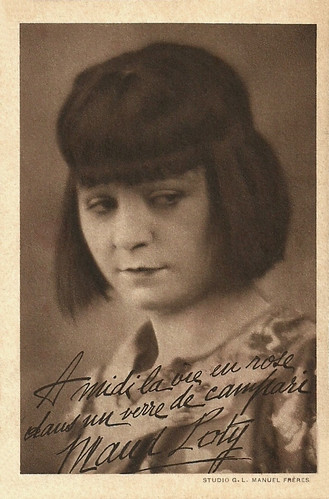French actress Maud Loty (1894-1976) was a popular Vaudeville star of the 1920s and 1930s. 'La Maud' was also active in the silent cinema during the 1910s.

French postcard by David Campari, Paris. Photo: Studio G.L. Manuel Frères. Caption: 'A midi la vie en rose dans un verre de Campari.' (At noon 'la vie en rose' in a glass of Campari.)

French publicity card. Drawing by Marthe Antoine Gérardin. Publicity for the play 'Chipee!' at the Théâtre de l'Avenue in Paris, a play in which Maud Loty also sang. Her co-actors were a.o. Jean Dax and Marguerite Moreno.
Maud Loty aka Maud Loti was born Maud Charlotte Chaveron in Bordeaux, France, in 1894.
Already at the age of 14 she debuted in the cinema with the Pathé film Soeurs de lait/The Foster Sisters (Georges Denola, 1910), starring Jacques Normand and Georges Tréville. Afterwards, she played in André Heuzé’s adaptation of the novel Le Bossu/The Hunchback (1912), starring reputed Film d’Art actor Henry Krauss.
In 1917 Loty featured in a series of short comedies with the character Claudine, based on the novels by Colette and Willy: Claudine en ménage/Claudine in Household, Claudine à Paris/Claudine in Paris, Claudine s’en va/Claudine Goes, and Claudine à l’école/Claudine at School. Her last film role was the female lead in Baby (1918), directed by Louis Paglieri, who also acted as the male lead.
Loti’s main career, however, was in French Vaudeville. Between 1918 and 1930 Maud Loty was a highly popular singer and stage actress, nicknamed ‘La Maud’. She performed at Vaudeville houses such as the Théâtre des Capucines (where she played in 'Un chien qui rapporte', a revue by Grip), Théâtre des Variétés (e.g. 'Mademoiselle Flute' in 1927), Théâtre Michel, Concert Mayol, Palais-Royal, and Daunou.
She acted in Sacha Guitry’s play 'Le Miracle', while she was a good friend of singer Fréhel. She even had her own theatre, Le Théâtre de l’Avenue, decorated by Paul Poiret. Here she performed in 1926 in Chipée, with music by José Padilla. Loty’s Chinese-like face and her radical cut fringe were famous parts of her look.

French postcard by David Campari, Paris. Photo: Studio G.L. Manuel Frères. Caption: 'A midi la vie en rose dans un verre de Campari.'
Her stage career brought Maud Loty fame and fortune. She inhabited a sumptuous apartment on the Champs-Elysées, just above the famous perfume shop of Guerlain, where she gave opulent receptions. Money was thrown out of the window – though in 1933 she was imprisoned for four months because of paying her taxes with an uncovered cheque.
She startled the patrons of Deauville by wearing a dazzling bracelet around her leg on the beach. In the daytime Loty was the talk of the town at the races in Longchamp and Auteuil, while audiences applauded her when she appeared on stage in the evening.
She received crowned heads in her loge and was even invited to dinner by the notorious serial killer Landru, but narrowly escaped the fate of Landru’s other women. Loty was never afraid to launch melodrama in the newspapers to attract attention. When her favorite dog Mitson was run over by the car of his former mistress, this was big news – though reporters doubted whether the dog was really gone.
After the Second World War though, it was all over for Maud. Alcohol pushed her into the blackest misery, she became a clochard and in the late 1940s, she slept in the storage room of a cabaret in Pigalle. She survived by fortune-telling in bars and bistros and thanks to friendly grocers.
Artists led by Colette and Jean Cocteau raised a gala in her honour, but she was so drunk she forgot to come. In the end, she had to live in a mental institution. In 1976 Maud Loty died in Plessis-Robinson, at the age of 81.

French postcard. Photo: Studio G.L. Manuel Frères. Caption: "A midi la vie en rose dans un verre de Campari."
Sources: Jacqueline Strahm (Montmartre: beaux jours… et belles de nuits), and IMDb.
This post was last updated on 3 April 2025.
French postcard by David Campari, Paris. Photo: Studio G.L. Manuel Frères. Caption: 'A midi la vie en rose dans un verre de Campari.' (At noon 'la vie en rose' in a glass of Campari.)

French publicity card. Drawing by Marthe Antoine Gérardin. Publicity for the play 'Chipee!' at the Théâtre de l'Avenue in Paris, a play in which Maud Loty also sang. Her co-actors were a.o. Jean Dax and Marguerite Moreno.
Her radical-cut fringe
Maud Loty aka Maud Loti was born Maud Charlotte Chaveron in Bordeaux, France, in 1894.
Already at the age of 14 she debuted in the cinema with the Pathé film Soeurs de lait/The Foster Sisters (Georges Denola, 1910), starring Jacques Normand and Georges Tréville. Afterwards, she played in André Heuzé’s adaptation of the novel Le Bossu/The Hunchback (1912), starring reputed Film d’Art actor Henry Krauss.
In 1917 Loty featured in a series of short comedies with the character Claudine, based on the novels by Colette and Willy: Claudine en ménage/Claudine in Household, Claudine à Paris/Claudine in Paris, Claudine s’en va/Claudine Goes, and Claudine à l’école/Claudine at School. Her last film role was the female lead in Baby (1918), directed by Louis Paglieri, who also acted as the male lead.
Loti’s main career, however, was in French Vaudeville. Between 1918 and 1930 Maud Loty was a highly popular singer and stage actress, nicknamed ‘La Maud’. She performed at Vaudeville houses such as the Théâtre des Capucines (where she played in 'Un chien qui rapporte', a revue by Grip), Théâtre des Variétés (e.g. 'Mademoiselle Flute' in 1927), Théâtre Michel, Concert Mayol, Palais-Royal, and Daunou.
She acted in Sacha Guitry’s play 'Le Miracle', while she was a good friend of singer Fréhel. She even had her own theatre, Le Théâtre de l’Avenue, decorated by Paul Poiret. Here she performed in 1926 in Chipée, with music by José Padilla. Loty’s Chinese-like face and her radical cut fringe were famous parts of her look.

French postcard by David Campari, Paris. Photo: Studio G.L. Manuel Frères. Caption: 'A midi la vie en rose dans un verre de Campari.'
Launching melodrama
Her stage career brought Maud Loty fame and fortune. She inhabited a sumptuous apartment on the Champs-Elysées, just above the famous perfume shop of Guerlain, where she gave opulent receptions. Money was thrown out of the window – though in 1933 she was imprisoned for four months because of paying her taxes with an uncovered cheque.
She startled the patrons of Deauville by wearing a dazzling bracelet around her leg on the beach. In the daytime Loty was the talk of the town at the races in Longchamp and Auteuil, while audiences applauded her when she appeared on stage in the evening.
She received crowned heads in her loge and was even invited to dinner by the notorious serial killer Landru, but narrowly escaped the fate of Landru’s other women. Loty was never afraid to launch melodrama in the newspapers to attract attention. When her favorite dog Mitson was run over by the car of his former mistress, this was big news – though reporters doubted whether the dog was really gone.
After the Second World War though, it was all over for Maud. Alcohol pushed her into the blackest misery, she became a clochard and in the late 1940s, she slept in the storage room of a cabaret in Pigalle. She survived by fortune-telling in bars and bistros and thanks to friendly grocers.
Artists led by Colette and Jean Cocteau raised a gala in her honour, but she was so drunk she forgot to come. In the end, she had to live in a mental institution. In 1976 Maud Loty died in Plessis-Robinson, at the age of 81.

French postcard. Photo: Studio G.L. Manuel Frères. Caption: "A midi la vie en rose dans un verre de Campari."
Sources: Jacqueline Strahm (Montmartre: beaux jours… et belles de nuits), and IMDb.
This post was last updated on 3 April 2025.
No comments:
Post a Comment